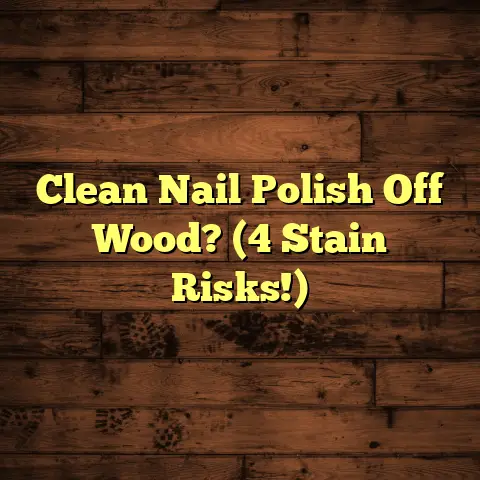Clean Grease Off Floors? (3 DIY Fixes You Need!)
Ever walk into your kitchen and feel like you’ve stumbled
onto a crime scene?
I’m not talking about a full-blown
disaster, but that single, shiny grease spot on your
otherwise pristine floor.
It’s like grease has a mind of its own, teleporting from
the pan to the most inconvenient location.
Don’t worry,
you’re not alone!
I’ve seen it all in my years as a
flooring contractor.
And I’m here to tell you, those grease stains don’t have to be a permanent fixture.
Let’s dive into understanding this slippery enemy and uncover three DIY fixes that will have your floors sparkling again.
Section 1: Understanding the Grease Enemy
What is Grease?
In the context of keeping your home clean, grease isn’t
just that stuff left in the frying pan.
It’s a broad term
for oily or fatty substances that can end up on your
floors.
Think of it as any type of animal or vegetable fat
that’s in a semi-solid or liquid state at room temperature.
In a home, grease stains commonly originate from cooking
oils, butter, meat drippings, and even some food spills.
Kitchens are the prime suspects, but dining areas can also
fall victim to accidental splatters.
Why is Grease Stubborn?
Grease is stubborn because of its chemical composition.
It’s primarily composed of non-polar molecules, which
means it doesn’t mix well with water, a polar substance.
This is why water alone often fails to remove grease
effectively.
Instead, grease clings tightly to surfaces, forming a bond
that’s difficult to break.
Common sources include:
- Cooking Oils: Vegetable oil, olive oil, canola oil.
- Food Spills: Sauces, gravies, dressings containing fats.
- Meat Drippings: Bacon grease, poultry fat, beef tallow.
These sources create a sticky mess that attracts dirt and becomes more challenging to remove over time.
The Importance of Tackling Grease Stains Promptly
Letting grease stains linger is a recipe for disaster.
Not only are they unsightly, but they can also damage
your flooring material.
Grease can seep into porous
surfaces like grout or unfinished wood, leading to
discoloration and degradation.
Furthermore, grease attracts dirt, dust, and even pests.
Imagine a trail of ants marching towards that forgotten
grease spot under your stove – not a pretty picture, right?
Prompt action is key to preventing long-term damage and maintaining a clean, healthy home environment.
Section 2: The Three DIY Fixes
Alright, let’s get down to business!
I’m going to share
three of my go-to DIY methods for tackling those stubborn
grease stains.
These are tried-and-true techniques that I’ve used countless times on various flooring types.
Important Note: Always test any cleaning solution in an inconspicuous area first to ensure it doesn’t damage or discolor your flooring.
DIY Fix #1: Baking Soda and Vinegar Powerhouse
This dynamic duo is a classic for a reason.
Baking soda
is a mild abrasive, while vinegar is an acid that helps
break down grease.
Materials Needed:
- Baking Soda
- White Vinegar
- Warm Water
- Soft Scrub Brush or Old Toothbrush
- Clean Cloth or Sponge
Step-by-Step Instructions:
- Create a Paste: Mix baking soda with a small amount
of warm water to form a thick paste.
The consistency should be similar to toothpaste. - Apply the Paste: Generously apply the baking soda paste to the grease stain, ensuring it completely covers the affected area.
- Let it Sit: Allow the paste to sit on the stain for
at least 30 minutes.
For tougher stains, you can leave it on for a few hours or even overnight. - Vinegar Rinse: Pour a small amount of white vinegar
onto the baking soda paste.
You’ll notice a fizzing reaction – this is a good thing! - Scrub Gently: Use a soft scrub brush or old
toothbrush to gently scrub the area.
Avoid using excessive force, especially on delicate flooring materials. - Wipe Clean: Use a clean, damp cloth or sponge to wipe away the baking soda and vinegar residue.
- Dry Thoroughly: Dry the area with a clean towel.
Why This Works:
The magic lies in the chemical reaction between baking
soda (a base) and vinegar (an acid).
This reaction helps
to break down the grease molecules, making them easier
to lift away from the flooring surface.
Baking soda’s mild abrasive properties also help to scrub away the stain without causing significant damage.
DIY Fix #2: Dish Soap and Hot Water Method
This is a simple yet effective solution, especially for
fresh grease stains.
Dish soap contains surfactants, which
are molecules that help to break down grease and oil.
Materials Needed:
- Dish Soap (Grease-Cutting Formula Recommended)
- Hot Water
- Mop or Sponge
- Bucket
Step-by-Step Instructions:
- Mix the Solution: Fill a bucket with hot water and
add a generous squirt of dish soap.
The water should feel hot to the touch, but not scalding. - Apply to the Stain: Dip a mop or sponge into the soapy water and apply it to the grease stain.
- Scrub Thoroughly: Scrub the area vigorously,
using a circular motion.
Pay attention to any edges or crevices where grease may have accumulated. - Rinse Well: Rinse the area thoroughly with clean,
hot water to remove all soap residue.
Soap residue can attract dirt and leave a sticky film. - Dry Completely: Use a clean towel or mop to dry the area completely.
Why This Works:
Dish soap contains surfactants, which are molecules with
both water-loving (hydrophilic) and grease-loving
(lipophilic) properties.
These surfactants surround the
grease molecules, lifting them away from the surface and
suspending them in the water.
Hot water helps to further break down the grease and makes it easier for the surfactants to do their job.
DIY Fix #3: Lemon Juice and Olive Oil Solution
This might sound like a strange combination, but trust me,
it works!
Lemon juice is a natural degreaser, while olive
oil can help to restore shine to certain flooring types,
especially wood.
Materials Needed:
- Fresh Lemon Juice
- Olive Oil
- Spray Bottle
- Soft Cloth
Step-by-Step Instructions:
- Mix the Solution: In a spray bottle, mix equal parts lemon juice and olive oil.
- Shake Well: Shake the bottle vigorously to ensure the ingredients are well combined.
- Spray the Stain: Spray the lemon juice and olive oil mixture directly onto the grease stain.
- Let it Sit: Allow the mixture to sit on the stain for about 5-10 minutes.
- Buff with a Cloth: Use a soft cloth to buff the
area in a circular motion.
This will help to lift the grease and restore shine to the floor. - Wipe Away Excess: Wipe away any excess oil with a clean cloth.
Why This Works:
Lemon juice contains citric acid, a natural degreasing
agent that helps to break down grease and oil.
Olive oil,
on the other hand, acts as a polishing agent, helping to
restore shine and protect the flooring surface.
This method is particularly effective for wood floors, as the olive oil can help to condition the wood and prevent it from drying out.
Section 3: Additional Tips for Maintaining Clean Floors
Prevention is always better than cure, right?
Here are
some tips to help you prevent grease stains in the first
place:
- Use Splatter Guards: When cooking, use splatter guards on your frying pans to prevent grease from splattering onto the floor.
- Clean Spills Promptly: Wipe up spills immediately before they have a chance to set in.
- Use Floor Mats: Place floor mats in high-traffic areas, such as in front of the stove and sink, to catch spills and grease.
- Regular Cleaning: Establish a regular cleaning
routine to keep your floors looking their best.
This includes sweeping or vacuuming regularly and mopping as needed.
Quick Guide to Regular Maintenance Cleaning:
Note: Always follow the manufacturer’s instructions for cleaning your specific flooring type.
Conclusion
So, there you have it!
Three DIY fixes to conquer those
pesky grease stains that threaten to spoil the beauty of
your floors.
Remember, baking soda and vinegar are a powerful combination, dish soap and hot water are a simple yet effective solution, and lemon juice and olive oil can restore shine to certain flooring types.
With a little creativity and resourcefulness, you can
tackle any grease stain that comes your way.
Embrace the
art of home cleaning, and you’ll be amazed at the
results!
Now, go forth and conquer those grease stains!
Your floors
will thank you for it.





